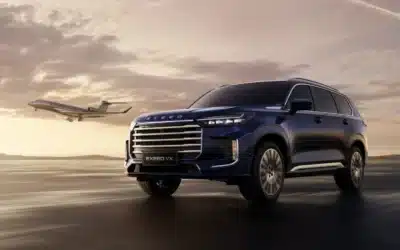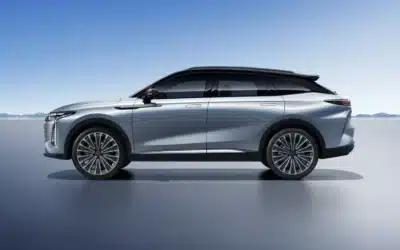
Here’s a striking fact: the Earth receives about 173,000 terawatts (TW) of solar energy at any given moment. That’s more than 10,000 times the world’s current total energy use. In one hour, the sunlight striking Earth delivers more energy than the entire world consumes in a year. So it makes sense to try to harness some of that energy to power our electric vehicles directly.
Let’s have a look at three companies – all based in the US – that are vying to launch direct solar charging solutions.
Go Sun
The EV Solar Charger from Go Sun is an innovative solar panel system that can be attached to any EV via a roof rack while the car is parked. Weighing approximately 32 kg, this charger can deliver around 1,200 watts of solar power, translating into roughly 50 km of additional driving range per day. Its compact, foldable design allows it to be easily stored within the vehicle when not in use and swiftly deployed upon parking. Besides its primary function as a charger, the device also acts as a shade to reduce the car’s internal temperature.
“The EV Solar Charger represents a significant advance in solar energy technology for electric vehicles,” stated a Go Sun spokesperson. “With this development, we aim to make EV ownership more viable and appealing by mitigating one of the prevalent concerns – the inconvenience of charging and range limitations.”
The EV Solar Charger is only available in the US at the moment, with deliveries starting in 2025. It will be sold for $2,999, so it’s not cheap and probably won’t pay back in the short-term.
While the EV Solar Charger isn’t intended to completely replace existing charging options, it allows for incremental charging throughout the day. This could be particularly advantageous for drivers who may not have immediate access to charging stations during the day.
Enteligent
Another pioneering California-based startup, Enteligent, has announced the launch of the TLCEV T1, billed as the world’s first solar direct current (DC) to DC electric vehicle charger.
This is also not available yet, but can be pre-ordered.
The TLCEV T1 charger enables power from photovoltaic arrays to be used directly for charging electric vehicles, bypassing the conventional DC-to-alternating current (AC) conversion and then back to DC.
This approach is reported to significantly reduce energy losses by up to 20%. By eliminating the need for a separate inverter, the charger can operate more efficiently and integrate seamlessly into existing photovoltaic circuits.
The company’s breakthrough product can connect directly to one or two solar inputs, with each input accommodating a voltage range between 340 and 600 volts and a maximum current of 20 amps. With a maximum power output rated at 12.5 kilowatts, the charger can deliver power directly to an EV’s battery without the need for an intermediary AC to DC converter.
Equipped with a CCS1 connector by default (with options for CCS2 or NACS plugs), the TLCEV T1 is designed for compatibility with various EV models. It can also be integrated with existing solar setups that include an inverter through a double-throw switch, allowing users to direct the output from the photovoltaic strings either to the charger or the inverter.
Although primarily aimed at daytime operations under sunlight, the charger is versatile enough to accept any DC input, such as those from battery backup systems, thereby broadening its utility and enhancing its appeal to a market increasingly keen on renewable energy solutions.
Pre-orders require a refundable fee of $250, with an “early bird” price set at $2,249. Post pre-order, the price is anticipated to rise to $2,499, although the timeline for this remains unspecified. Delivery estimates are also presently unavailable on the company’s website.
Investors think the company is onto something as Enteligent has secured $6 million in funding,. The company also announced that one of its other groundbreaking products, a 25 kW DC-to-DC bidirectional charger, will be supplied to a major logistics company for charging electric delivery vehicles.

Beam Global’s BeamSpot sustainable curbside EV charging solution. Illustration is indicative only. Provided by Beam.
Beam Global
Beam Global, also based in sunny California, has unveiled a revolutionary initiative to integrate curbside EV charging with renewable energy into streetlights.
Dubbed the BeamSpot, the innovative streetlight charger merges solar panels and small wind turbines to generate on-site renewable energy. BeamSpot stands 12m tall (or 9.1m without the wind turbine option) and boasts a dual energy generation system capable of producing 1 kilowatt each from solar and wind sources, totalling up to 2 kilowatts when both options are utilised. The system is also equipped with a 15 kilowatt-hour (kWh) battery to store this energy, ensuring maximised utility.
This setup not only powers the streetlight but also enables substantial EV charging capacity. Beam Global claims the BeamSpot can deliver a charging output of up to 5.76 kilowatts, providing approximately 350 km of added range after a full day of charging. This makes the BeamSpot a potentially game-changing solution for apartment dwellers and urban EV owners who might struggle to find convenient charging options.
One of the standout features of the BeamSpot is its ability to be installed on existing streetlight foundations. This significantly simplifies the construction and permitting processes compared to conventional EV chargers, facilitating a quicker and less disruptive expansion of charging infrastructure. The integration also ensures that no additional sidewalk space is occupied, maintaining the urban landscape’s functionality and aesthetic.
Beam Global’s initiative is not happening in isolation. Various municipalities across the United States have shown a keen interest in streetlight EV chargers. Notably, AmpUp and EVSE, two industry competitors, recently secured a contract with the Los Angeles Bureau of Street Lighting. They are set to add 150 streetlight EV chargers to Los Angeles, contributing to the city’s ambitious goal of installing 10,000 streetlight chargers.
Seattle, in 2022, rolled out a plan to offer curbside EV chargers upon request, reflecting a growing trend of municipalities exploring flexible and efficient charging solutions. Kansas City and New York began testing streetlight chargers in 2021, with New York reporting high rates of utilisation, underscoring the practicality and popularity of the concept.
In London various boroughs such as Hammersmith & Fulham in the west of the city have installed extensive networks of street light chargers in residential areas, albeit not solar powered.
To date this kind of technology hasn’t been adopted across the Middle East despite almost limitless sunshine.











